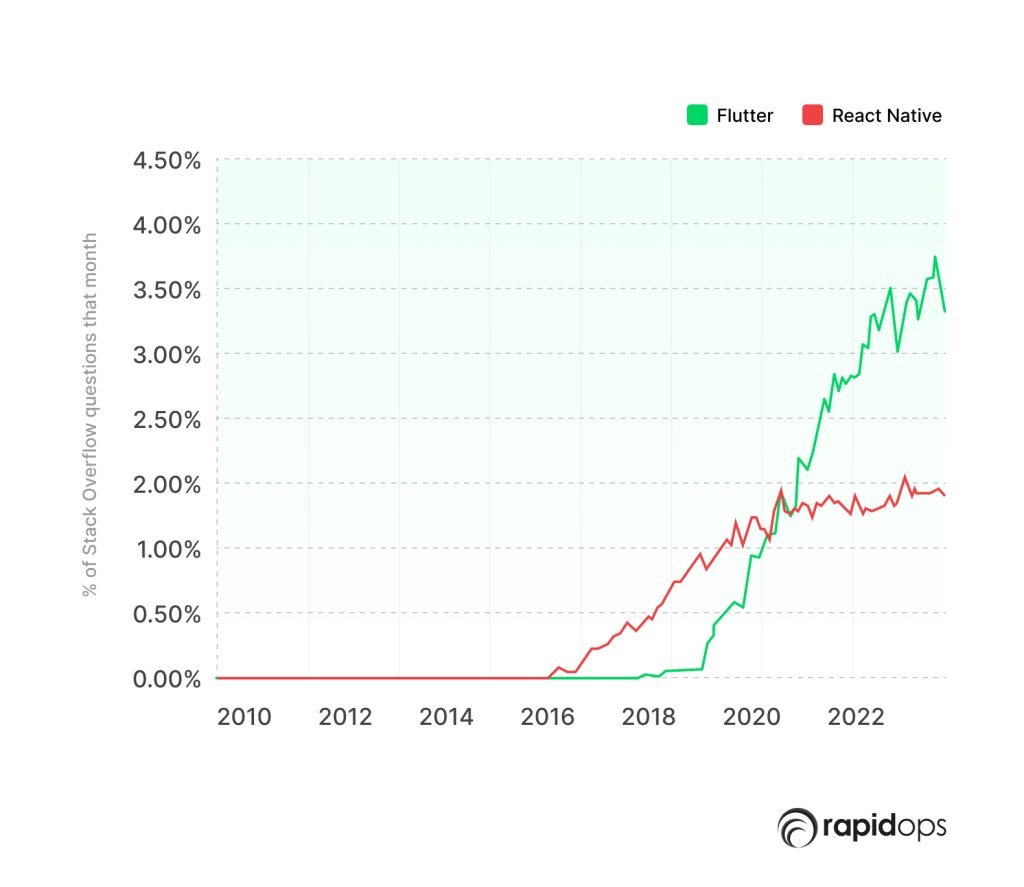- Engineering
- 7 min read
- November 2022
Flutter vs React Native: Clear Comparison Factors
When it comes to fierce competition among the frameworks in the mobile app development market, no frameworks can beat Flutter and React Native.
These two popular cross-platform development technologies have always remained the talk of the development world. From features, functionalities, APIs, and the user interface to support, they give robust competition to each other.
And why not?
These frameworks are the leading market players used for cross-platform application development. They are the most sought-after open-source frameworks that enable developers to bring scalable and flexible solutions to the table.
With less time to market, delivering business applications using these frameworks becomes relatively easy. Both these frameworks have a great portfolio, with the industry giants showing credence in their abilities.
If you aren’t sure which of these frameworks is best for your app development project, here's an elaboration that can help you.
Before we dive into Flutter vs React Native based on various aspects, let’s have a quick overview:
React Native: A brief
This JavaScript-based framework centers around the native deployment of business applications significantly viable with Android and iOS.
React Native solutions are a blend of XML - Esque markup and JavaScript, which is otherwise called JSX.
It is supported by the web-based media monster Facebook, with more than 50 devoted designers chipping away at the structure. Since its initial release six years ago in 2015, it has been the most popular open-source framework that uses JavaScript.
Use cases
- React Native is an uncomplicated and easy-to-use cross-platform app development framework.
- Developers love the framework for the ease it offers in building prototype applications.
- Business applications that need simple UI can easily be created here.
- Using Flexbox, the framework helps develop solutions that may look native but have highly responsive UX.
- The applications are designed to run with synchronous APIs.
- The components of the application are reusable.
Framework portfolio
Most tech giants find this framework best suited for their business idea. Some of its prominent users are:
- Facebook: With simple navigation, Facebook developed a supercharged, steady mobile UI
- Bloomberg: Streamlined, easy-to-get-to, customized content for clients with programmed code-invigorating provisions
- SoundCloud: Bridged the delay among refreshes and fixed forms for iOS and Android
- Instagram: Implemented message pop-up as WebView without building route foundation
- Wix: Achieved high velocity and spryness in advancing configurable routes and screen alternatives
- Walmart: Improved client experience by building smooth in-application animations indistinguishable from local usefulness

These top companies have transformed their operations with React native solutions and services.
They bestow their trust in the framework for the convenience of development and marketing ease it offers.
React Native might seem like the right choice for your business application.
But wait! Don’t conclude too soon.
Flutter: A brief
Flutter is another open-source framework that offers scalable and flexible solutions. Created by Google, this framework works with the language Dart.
It is often addressed as an upgraded UI tool stash utilized to assemble cross-stage applications with a solitary codebase in the industry. The app development team gets to create expressive and adaptable UI with local execution.
Moreover, it is upheld and contributed by a group of Google engineers and the whole local area.
Flutter app development service providers often deliver futuristic and customer-centric solutions for maximum profits.
Use cases
- Easy to develop MVP mobile applications
- With Skia, get a high-performing app for your business
- Develop applications that operate with OS-level features
- Use highly advanced OS plugins that work with simple logic
- Applications with vast data integration can easily be reactivated with the framework
- With high-level professional widgets, it becomes easier to work with flexible UI
Framework portfolio
- Alibaba: The eCommerce giant created a solitary tap navigation insight for all applications with high FPS and a solitary codebase.
- Google Ads: Google Ads leveraged Dart bundles, Firebase AdMob modules, and static utility classes of Flutter to give a convenient client experience in iOS and Android.
- Tencent: With less than five flutter app developers on the team, Tencent built an associated and shared gadget experience between clients with multi-stage support.
- eBay: The international eCommerce giant relied on the complex and redid edge-controlled AI highlights by coordinating Flutter and Firebase to make autoML for eBay Motors.
- BMW: The automobile star developed elite UIs by utilizing flutter BLoC for the board.

These are some of the best applications that use the framework. With such a portfolio, Flutter has proven its existence in the industry.
First released in 2017, the framework has gained a strong position in the market over four years.
Flutter vs React Native: Where do they stand now?

This graph from Stack Overflow is quite insightful. Since 2010, the popularity of both Flutter and React Native has kept changing and the wave is quite enlightening.
The graph is based on the percentage of inquiries the platform received through users for Flutter and React Native among other technologies/frameworks.
Not sure if you want to hire React Native app developers or Flutter experts? We further share a clear comparison of these frameworks to help you make the right choice:
Flutter vs React Native: A clear comparison
Here is a quick comparison of both frameworks that would help you make a well-thought-out and correct decision.
It would ensure your business objectives are satisfied with the solutions you would take to the market.
Let’s look at an elaborative comparison:

Flutter vs React Native: Quintessential features
1. User interface
The UI of a website or application matters a lot, as it is the central point at which human users interact with your business. So, let’s see which framework gives a better UI experience.
Flutter
- Compared to the older versions, these applications look good on the updated OS versions.
- With a singular code base, these applications have a similar look on iOS and Android.
- The applications built on this framework will adapt to the look and feel of the native components.
React Native
- The components of the application look similar to the native ones.
- App components are upgraded as the OS is upgraded. Thus, there is less effort in keeping up with the latest advancements.
2. Sharing code
Nowadays, building software applications are complex. Therefore, organizations adopt the practice of building applications with sharing code.
When it comes to sharing the code, both frameworks are giving fierce competition to each other.
Flutter
It allows a single codebase across all platforms and devices. Thus, this is the right choice if you want to build an application that works across all devices.
React Native
Your React Native app development team would need to integrate a third-party library to affirm that the application works across all devices and operating systems with a similar look and feel.
3. Time to market
Time-to-market is one of the most crucial factors in achieving a solid position in the market.
Let’s see which framework will help you reduce time to market releasing apps and their updates faster and offers tremendous benefits:
Flutter
Since the framework uses a single codebase, the applications are ready to market soon.
React Native
With third-party integration and modifications in the code for various operating systems and devices, the time to market is relatively higher.
4. Competitive advantage
Every company wants to diversify its products or business approaches to sustain its strong position in the marketplace.
Comparing Flutter and React Native on this parameter is quite exciting as both frameworks share the ability to provide competitive advantages with unique functionalities.
Flutter
- Because the rich widgets offer a great feel and look
- Since it is new in the market, the community is still growing
- Essential documents to make it easy to start developing
- Appreciable support from the Flutter team
- More advancements on their way for the web would let the single codebase development be more accessible and convenient
- Time to market is exceptionally unbelievable
React Native
- Much stable framework as compared to Flutter
- Immensely popular in the market with a great clientele to its name
- Mature community as it has been in the market for almost a decade
- Several tutorials available for support
These are the essential points of comparison for Flutter and React Native.
Depending on your choice of application and business objective, you can always hire the one that helps you earn the best.
These frameworks are well suited for cross-platform development and have made it easier for developers worldwide to build solutions that can make a strong presence in the market.
Launch your intuitive mobile applications today, offering exceptional experiences to users and creating business opportunities!
Wrapping up
The comparison here clearly reflects why these frameworks face such intense rivalry. Developers love both and choose either, depending on the client’s business objective and requirements.
These frameworks transform how the world would do business and advertise its products.
The mobile app industry has grown more extensive and technical as compared to a few years ago. The trend of owning a well-defined online shop has changed to the need of the hour.
Now we tend to make sure to build a strong presence in the market that affirms our business and generates significant profits.
The technology is evolving daily, but these frameworks have survived the market competition for their features and ease.
It’s always worth discussing your ideas with an experienced team; be it a project or a product.
A feature-rich yet robust mobile app can't be built in a day, just as they say for Rome!




